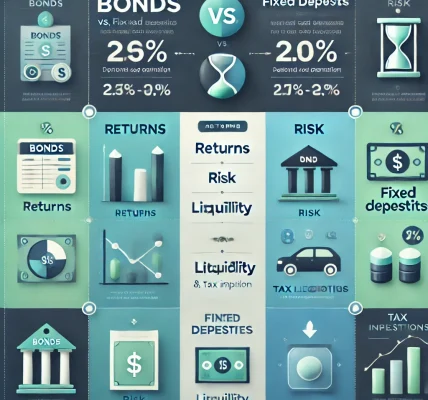Introduction
Investors seeking predictable income often rely on bonds as a cornerstone of their portfolios. However, while bonds provide consistent interest payments, they expose investors to an often-overlooked threat—reinvestment risk. This risk arises when the proceeds from maturing bonds or coupon payments are reinvested at a lower interest rate than the original bond, potentially reducing overall returns.
In this comprehensive guide, we will explore the concept of bond reinvestment risk, analyze its impact on portfolios, and provide actionable strategies to mitigate the risk and safeguard your returns.
🎯 What Is Reinvestment Risk?
Reinvestment risk is the likelihood that the proceeds from coupon payments or matured bonds will be reinvested at a lower rate than the original investment. This risk is more pronounced in a declining interest rate environment when bond yields decrease over time.
✅ How It Works:
- An investor purchases a bond with a 5% coupon rate.
- If interest rates fall, the proceeds from coupon payments or maturing bonds may need to be reinvested at a lower rate, reducing future income.
📊 Understanding the Impact of Reinvestment Risk
Reinvestment risk can erode returns over time, especially for long-term bond investors. Understanding the impact is essential for devising strategies to protect returns.
✅ How Reinvestment Risk Affects Investors:
- 📉 Lower Future Returns: Reduced income from reinvested proceeds.
- 📊 Erosion of Portfolio Growth: Compounding effect diminishes future value.
- 💸 Potential Income Shortfall: Especially critical for retirees relying on bond income.
⚡ Key Scenarios Where Reinvestment Risk Occurs
✅ 1. Coupon Payments Reinvestment
Bonds with periodic coupon payments expose investors to reinvestment risk if interest rates decline between payment intervals.
✅ Example:
- A 10-year bond with a 6% coupon rate pays semi-annual interest.
- If interest rates fall, reinvesting the coupon payments may yield lower returns.
✅ 2. Maturity of Fixed-Income Securities
When a bond matures, investors may need to reinvest the principal in a lower-yielding bond if rates have declined.
✅ Example:
- A 5-year bond maturing in a low-interest environment leaves the investor with limited high-yield reinvestment options.
✅ 3. Callable Bonds Redemption Risk
Callable bonds allow issuers to redeem bonds before maturity if interest rates decline, forcing investors to reinvest proceeds at lower rates.
✅ Example:
- A 20-year callable bond is redeemed after 10 years when rates drop, leaving the investor with reinvestment challenges.
📈 Factors Influencing Reinvestment Risk
📉 1. Interest Rate Environment
Reinvestment risk is heightened in a declining interest rate environment, where falling yields limit the opportunity for high returns.
✅ Impact:
- Reduced overall returns for fixed-income portfolios.
🕒 2. Bond Maturity Period
The longer the bond’s maturity period, the greater the likelihood that interest rate changes will impact reinvestment opportunities.
✅ Impact:
- Short-term bonds are less exposed to reinvestment risk than long-term bonds.
🔥 3. Bond Type and Structure
Bonds with frequent coupon payments or callable features increase reinvestment risk.
✅ Impact:
- Callable bonds and high-coupon bonds magnify the likelihood of reinvestment risk.
🛡️ How to Safeguard Your Returns from Reinvestment Risk
While reinvestment risk cannot be completely eliminated, strategic planning can significantly reduce its impact. Below are actionable strategies to protect your portfolio.
✅ 1. Create a Bond Ladder to Spread Maturities
Bond laddering involves purchasing bonds with staggered maturity dates, allowing proceeds to be reinvested gradually rather than all at once.
✅ Why It Works:
- Reduces the impact of reinvesting at lower rates.
- Provides consistent cash flow and flexibility.
✅ How to Build a Bond Ladder:
- Buy bonds with maturities of 1, 3, 5, and 10 years.
- As each bond matures, reinvest proceeds in a new bond at prevailing rates.
✅ 2. Consider Zero-Coupon Bonds to Eliminate Coupon Reinvestment Risk
Zero-coupon bonds do not pay periodic interest, eliminating the need for reinvesting coupon payments. These bonds are issued at a discount and pay the face value upon maturity.
✅ Why It Works:
- No periodic reinvestment risk.
- Protects against declining interest rates.
✅ Example:
- A 10-year zero-coupon bond purchased at a discount matures at face value, eliminating reinvestment concerns.
✅ 3. Use Fixed Annuities or Income Funds for Predictable Returns
Fixed annuities and income-focused funds provide guaranteed payouts and predictable income, reducing reinvestment risk.
✅ Why It Works:
- Locks in a fixed rate for a specific period.
- Ideal for retirees seeking consistent income.
✅ 4. Opt for Bullet Bonds with Single Maturity Dates
Bullet bonds have a single maturity date, reducing the frequency of reinvestment and minimizing reinvestment risk.
✅ Why It Works:
- Simplifies reinvestment decisions.
- Ideal for investors seeking long-term stability.
✅ Example:
- A 10-year bullet bond that matures at the end of the term, avoiding periodic reinvestment.
✅ 5. Invest in Floating Rate Bonds to Mitigate Interest Rate Fluctuations
Floating rate bonds have interest rates that adjust periodically based on prevailing market rates, reducing reinvestment risk in declining rate environments.
✅ Why It Works:
- Protects against falling interest rates.
- Provides variable income aligned with current market conditions.
✅ Example:
- A 5-year floating rate bond with interest payments linked to a benchmark rate.
📊 Comparing Strategies to Mitigate Reinvestment Risk
| Strategy | Effectiveness | Ideal For |
|---|---|---|
| Bond Ladder | High | Long-term investors seeking stability |
| Zero-Coupon Bonds | Very High | Investors avoiding coupon reinvestment |
| Fixed Annuities | Moderate | Retirees needing predictable income |
| Bullet Bonds | High | Conservative investors |
| Floating Rate Bonds | Moderate to High | Investors seeking inflation protection |
💡 Case Study: Protecting Returns from Reinvestment Risk
Scenario:
- Investor A has a $200,000 bond portfolio with bonds maturing at different intervals.
- Concerned about reinvestment risk in a declining rate environment, they build a bond ladder and allocate 30% of the portfolio to zero-coupon bonds to eliminate coupon reinvestment risk.
✅ Result:
- The investor mitigates reinvestment risk and maintains predictable returns.
⚡ Potential Pitfalls and How to Avoid Them
⚠️ 1. Ignoring Callable Bonds’ Impact on Reinvestment
Callable bonds may be redeemed by issuers before maturity, increasing the need for reinvestment at lower rates.
✅ Solution:
- Opt for non-callable bonds or diversify with callable bonds to mitigate risk.
⚠️ 2. Concentrating Too Much on Short-Term Bonds
Focusing too heavily on short-term bonds exposes the portfolio to frequent reinvestment.
✅ Solution:
- Diversify across short, medium, and long-term maturities.
⚠️ 3. Misjudging Interest Rate Movements
Incorrectly predicting interest rate movements can lead to reinvestment at suboptimal rates.
✅ Solution:
- Use floating rate bonds to protect against rate changes.
🎉 Conclusion: Safeguard Your Returns from Reinvestment Risk
Reinvestment risk can erode the long-term returns of a fixed-income portfolio, but with strategic planning and diversification, investors can effectively mitigate this risk. Implementing bond ladders, zero-coupon bonds, floating rate bonds, and fixed annuities ensures predictable returns and minimizes exposure to fluctuating interest rates.
By understanding and addressing reinvestment risk, investors can safeguard their returns and maintain consistent portfolio growth even in challenging market conditions.




